| Part of a series on the |
| Culture of Pakistan |
|---|
 |
| Traditions |
| Folklore |
| Sport |
Pakistan is a multilingual country with over 70 languages spoken as first languages.[3][4] The majority of Pakistan's languages belong to the Indo-Iranian group of the Indo-European language family.[5][6]
Urdu is the national language and the lingua franca of Pakistan, and while sharing official status with English, it is the preferred and dominant language used for inter-communication between different ethnic groups.[3][4] Numerous regional languages are spoken as first languages by Pakistan's various ethnolinguistic groups. Languages with more than a million speakers each include Punjabi, Pashto, Sindhi, Saraiki, Urdu, Balochi, Hindko, Pahari-Pothwari[lower-alpha 2] and Brahui.[7] There are approximately 60 local languages with fewer than a million speakers.[8][9]
List of languages
The 2022 edition of Ethnologue lists 77 established languages in Pakistan. Of these, 68 are indigenous and 9 are non-indigenous. In terms of their vitality, 4 are classified as 'institutional', 24 are 'developing', 30 are 'vigorous', 15 are 'in trouble', and 4 are 'dying'.[8]
| Language | Province[lower-alpha 3] | Language group |
|---|---|---|
| Aer | Sindh | Indo-Aryan |
| Badeshi | Khyber Pakhtunkwa | Iranian |
| Bagri | Punjab, Sindh | Indo-Aryan |
| Balochi, Eastern | Balochistan, Punjab, Sindh | Iranian |
| Balochi, Southern | Balochistan, Sindh | Iranian |
| Balochi, Western | Balochistan, Sindh | Iranian |
| Balti | Gilgit Baltistan | Sino-Tibetan |
| Bateri | Khyber Pakhtunkwa | Indo-Aryan |
| Bhaya | Sindh | Indo-Aryan |
| Brahui | Balochistan, Sindh | Dravidian |
| Burushaski | Gilgit Baltistan | Isolate |
| Chilisso | Khyber Pakhtunkwa | Indo-Aryan |
| Dameli | Khyber Pakhtunkwa | Indo-Aryan |
| Dari | Khyber Pakhtunkwa | Iranian |
| Dehwari | Balochistan | Iranian |
| Dhatki | Sindh | Indo-Aryan |
| Domaaki | Gilgit Baltistan | Indo-Aryan |
| English | Federal co-official | Germanic |
| Gawar-Bati | Khyber Pakhtunkwa | Indo-Aryan |
| Gawri | Khyber Pakhtunkwa | Indo-Aryan |
| Ghera | Sindh | Indo-Aryan |
| Goaria | Sindh | Indo-Aryan |
| Gowro | Khyber Pakhtunkwa | Indo-Aryan |
| Gujarati | Sindh | Indo-Aryan |
| Gujari | Azad Kashmir, Gilgit Baltistan, Khyber Pakhtunkwa, Punjab | Indo-Aryan |
| Gurgula | Sindh | Indo-Aryan |
| Hazaragi | Balochistan | Iranian |
| Hindko, Northern | Azad Kashmir, Khyber Pakhtunkwa | Indo-Aryan |
| Hindko, Southern | Khyber Pakhtunkwa, Punjab | Indo-Aryan |
| Jadgali | Balochistan, Sindh | Indo-Aryan |
| Jandavra | Sindh | Indo-Aryan |
| Jogi | Sindh | Indo-Aryan |
| Kabutra | Sindh | Indo-Aryan |
| Kacchi | Sindh | Indo-Aryan |
| Kalasha | Khyber Pakhtunkwa | Indo-Aryan |
| Kalkoti | Khyber Pakhtunkwa | Indo-Aryan |
| Kamviri | Khyber Pakhtunkwa | Iranian |
| Kashmiri | Azad Kashmir | Indo-Aryan |
| Kati | Khyber Pakhtunkwa | Iranian |
| Khetrani | Balochistan | Indo-Aryan |
| Khowar | Gilgit Baltistan, Khyber Pakhtunkwa | Indo-Aryan |
| Kohistani, Indus | Khyber Pakhtunkwa | Indo-Aryan |
| Koli, Kachi | Sindh | Indo-Aryan |
| Koli, Parkari | Sindh | Indo-Aryan |
| Koli, Wadiyari | Sindh | Indo-Aryan |
| Kundal Shahi | Azad Kashmir | Indo-Aryan |
| Lasi | Balochistan | Indo-Aryan |
| Loarki | Sindh | Indo-Aryan |
| Mankiyali | Khyber Pakhtunkwa | Indo-Aryan |
| Marwari | Punjab, Sindh | Indo-Aryan |
| Mewati | Punjab, Sindh | Indo-Aryan |
| Memoni | Sindh | Indo-Aryan |
| Oadki | Punjab, Sindh | Indo-Aryan |
| Ormuri | Khyber Pakhtunkwa | Iranian |
| Pahari-Pothwari | Azad Kashmir, Punjab | Indo-Aryan |
| Pakistan Sign Language | Throughout | Indo-Pakistani Sign Language |
| Palula | Khyber Pakhtunkwa | Indo-Aryan |
| Pashto, Central | Balochistan, Khyber Pakhtunkwa, Punjab | Iranian |
| Pashto, Northern | Khyber Pakhtunkwa, Punjab | Iranian |
| Pashto, Southern | Balochistan, Khyber Pakhtunkwa, Punjab | Iranian |
| Punjabi, Eastern | Punjab | Indo-Aryan |
| Punjabi, Western | Punjab | Indo-Aryan |
| Saraiki | Balochistan, Khyber Pakhtunkwa, Punjab, Sindh | Indo-Aryan |
| Sarikoli | Khyber Pakhtunkwa | Iranian |
| Savi | Khyber Pakhtunkwa | Indo-Aryan |
| Shina | Azad Kashmir, Gilgit Baltistan, Khyber Pakhtunkwa | Indo-Aryan |
| Shina, Kohistani | Khyber Pakhtunkwa | Indo-Aryan |
| Sindhi | Balochistan, Sindh | Indo-Aryan |
| Sindhi Bhil | Sindh | Indo-Aryan |
| Tamil | Sindh | Dravidian |
| Torwali | Khyber Pakhtunkwa | Indo-Aryan |
| Urdu | Throughout | Indo-Aryan |
| Ushojo | Khyber Pakhtunkwa | Indo-Aryan |
| Vaghri | Sindh | Indo-Aryan |
| Wakhi | Gilgit Baltistan, Khyber Pakhtunkwa | Iranian |
| Waneci | Balochistan | Iranian |
| Yadgha | Khyber Pakhtunkwa | Iranian |
Statistics
| Rank | Language | 2017 census | 1998 census | 1981 census | 1961 census | 1951 census |
|---|---|---|---|---|---|---|
| 1 | Punjabi* | 38.78% | 44.15% | 48.17% | 56.39% | 57.08% |
| 2 | Pashto | 18.24% | 15.42% | 13.35% | 8.47% | 8.16% |
| 3 | Sindhi | 14.57% | 14.1% | 12.7% | 12.59% | 12.85% |
| 4 | Saraiki* | 12.19% | 10.53% | 9.54% | ||
| 5 | Urdu | 7.08% | 7.57% | 7.60% | 7.57% | 7.05% |
| 6 | Balochi | 3.02% | 3.57% | 3.02% | 2.49% | 3.04% |
| 7 | Others | 6.12% | 4.66% | 5.62% | 12.49% | 11.82% |
* Saraiki was included with Punjabi in the 1951 and 1961 censuses.
Official languages
Urdu (official language)
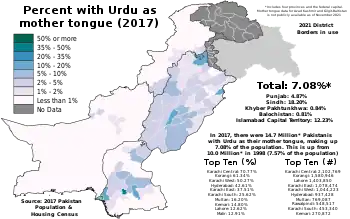
Urdu (اردو) is the national language (قومی زبان) and lingua franca of Pakistan.[12] Although only about 7% of Pakistanis speak it as their first language, it is widely spoken and understood as a second language by the vast majority of Pakistanis.[13][14]
Urdu was chosen as a symbol of unity for the new state of Pakistan in 1947, because it had already served as a lingua franca among Muslims in north and northwest British India.[15] It is written, spoken and used in all provinces/territories of Pakistan, and together with English as the main languages of instruction,[16] although the people from differing provinces may have different native languages.[17]
Urdu is taught as a compulsory subject up to higher secondary school in both English and Urdu medium school systems, which has produced millions of second-language Urdu speakers among people whose native language is one of the other languages of Pakistan – which in turn has led to the absorption of vocabulary from various regional Pakistani languages,[18] while some Urdu vocabularies has also been assimilated by Pakistan's regional languages.[19][20]
English (co-official language)
English is a co-official language of Pakistan and is widely used in the executive, legislative and judicial branches as well as to some extent in the officer ranks of Pakistan's armed forces. Pakistan's Constitution and laws were written in English and are now being re-written in the local languages. It is also widely used in schools, colleges and universities as a medium of instruction. English is seen as the language of upward mobility, and its use is becoming more prevalent in upper social circles, where it is often spoken alongside native Pakistani languages. In 2015, it was announced that there were plans to promote Urdu in official business, but Pakistan's Minister of Planning Ahsan Iqbal stated, "Urdu will be a second medium of language and all official business will be bilingual." He also went on to say that English would be taught alongside Urdu in schools.[21]
Major regional languages
Punjabi
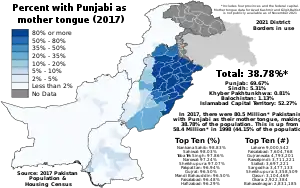
Punjabi (پنجابی) is an Indo-Aryan language primarily spoken in the Punjab province of Pakistan, with the prominent dialect being the Majha dialect, written in the Shahmukhi script. Punjabi is the most widely spoken language in Pakistan. It is spoken as a first language by 38.78% of Pakistanis.[22] The language is spoken among a significant overseas diaspora, particularly in Canada, the United Kingdom, and the United States. Punjabi is unusual among the Indo-Aryan languages and the broader Indo-European language family in its usage of lexical tone.[23]
Pashto
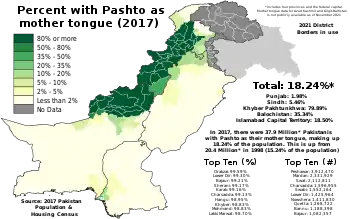
Pashto (پښتو) is an Iranian language spoken as a first language by more than 18.24% of Pakistanis, mainly in Khyber Pakhtunkhwa and in northern Balochistan as well as in ethnic Pashtun communities in the cities of Islamabad, Rawalpindi, Lahore, and most notably Karachi,[24][25][26][27] which may have the largest Pashtun population of any city in the world.[28] There are three major dialect patterns within which the various individual dialects may be classified; these are the Pakhto variety of Northern (Peshawar) variety, the southern Pashto spoken in the vicinity of Quetta, and the Wanetsi or Tareeno variety of northern Balochistan.
Sindhi

Sindhi (سنڌي) is an Indo-Aryan language spoken as a first language by almost 15% of Pakistanis, mostly in the Sindh province of Pakistan. The name "Sindhi" is derived from Sindhu, the original name of the Indus River.[29]
Like other languages of this family, Sindhi has passed through Old Indo-Aryan (Sanskrit) and Middle Indo-Aryan (Pali, secondary Prakrits, and Apabhramsha) stages of growth. 20th century Western scholars such as George Abraham Grierson believed that Sindhi descended specifically from the Vrācaḍa dialect of Apabhramsha (described by Markandeya as being spoken in Sindhu-deśa) but later work has shown this to be unlikely.[30] It entered the New Indo-Aryan stage around the 10th century CE.[31][32]
The six major known dialects of the Sindhi language are Siroli, Vicholi, Lari, Thari, Lasi and Kutchi.[33]
Saraiki
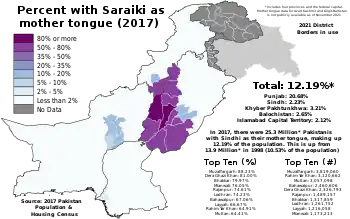
Saraiki (سرائیکی) is an Indo-Aryan language of the Lahnda group, spoken in central and southeastern Pakistan, primarily in the southern part of the province of Punjab. Saraiki is to a high degree mutually intelligible with Standard Punjabi[34] and shares with it a large portion of its vocabulary and morphology. At the same time in its phonology it is radically different[35] (particularly in the lack of tones, the preservation of the voiced aspirates and the development of implosive consonants), and has important grammatical features in common with the Sindhi language spoken to the south.[36]
Saraiki is the language of about 26 million people in Pakistan, ranging across southern Punjab, southern Khyber Pakhtunkhwa, and border regions of northern Sindh and eastern Balochistan.[37]
Balochi
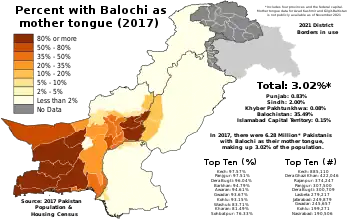
Balochi (بلوچی) is an Iranian language spoken as a first language by about 3% of Pakistanis, mostly in the Balochistan province. Rakshani is the major dialect group in terms of numbers. Sarhaddi is a sub-dialect of Rakshani. Other sub-dialects are Kalati (Qalati), Chagai-Kharani and Panjguri. Eastern Hill Balochi or Northern Balochi is very different from the rest.
Hindko

Hindko (ہندکو) is a cover term for a diverse group of Lahnda dialects spoken in several discontinuous areas in northwestern Pakistan, primarily in the provinces of Khyber Pakhtunkhwa and Punjab. Hindko is mutually intelligible with Punjabi and Saraiki,[38] and has more affinities with the latter than with the former.[39] Differences with other Punjabi varieties are more pronounced in the morphology and phonology than in the syntax.[40] The word Hindko, commonly used to refer to a number of Indo-Aryan dialects spoken in the neighbourhood of Pashto, likely originally meant "the Indian language" (in contrast to Pashto).[41] An alternative local name for this language group is Hindki.[42][lower-alpha 4]
Brahui
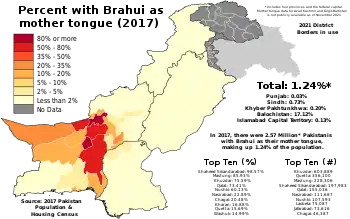
Brahui (براہوئی) is a Dravidian language spoken in the central part of Balochistan province. Brahui is spoken in the central part of Pakistani Balochistan, mainly in Kalat, Khuzdar and Mastung districts, but also in smaller numbers in neighboring districts, as well as in Afghanistan which borders Pakistani Balochistan; however, many members of the ethnic group no longer speak Brahui.[43]
Endangered languages

Other languages spoken by linguistic minorities include the languages listed below, with speakers ranging from a few hundred to tens of thousands. A few are highly endangered languages that may soon have no speakers at all.[44] The United Nations Educational, Scientific and Cultural Organization defines five levels of language endangerment between "safe" (not endangered) and "extinct":[45]
- Vulnerable - "most children speak the language, but it may be restricted to certain domains (e.g., home)"
- Definitely endangered – "children no longer learn the language as mother tongue in the home"
- Severely endangered – "language is spoken by grandparents and older generations; while the parent generation may understand it, they do not speak it to children or among themselves"
- Critically endangered – "the youngest speakers are grandparents and older, and they speak the language partially and infrequently"
- Extinct – "there are no speakers left; included in the Atlas if presumably extinct since the 1950s"
The list below includes the findings from the third edition of Atlas of the World's Languages in Danger (2010; formerly the Red Book of Endangered Languages), as well as the online edition of the aforementioned publication, both published by UNESCO.[46]
| Language | Status | Comments | ISO 639-3 |
|---|---|---|---|
| Balti | Vulnerable[45] | Also spoken in: India | bft |
| Bashkarik | Definitely endangered[45] | gwc, xka | |
| Badeshi | Critically endangered[45] | bdz | |
| Bateri | Definitely endangered[45] | btv | |
| Bhadravahi | Definitely endangered[45] | Also spoken in: India | bhd |
| Brahui | Vulnerable[45] | Also spoken in: Afghanistan | brh |
| Burushaski | Vulnerable[45] | bsk | |
| Chilisso | Severely endangered[45] | clh | |
| Dameli | Severely endangered[45] | dml | |
| Domaaki | Severely endangered[45] | dmk | |
| Gawar-Bati | Definitely endangered[45] | Also spoken in: Afghanistan | gwt |
| Gowro | Severely endangered[45] | gwf | |
| Jadgali | jdg | ||
| Kalasha language | Severely endangered[45] | Not to be confused with Kalasha-ala | kls |
| Kalkoti | Severely endangered[45] | ||
| Kati (Kamkata-viri, Kata-vari, Kamviri) |
Definitely endangered[45] | Also spoken in: Afghanistan | bsh, xvi |
| Khowar | Vulnerable[45] | khw | |
| Kundal Shahi | Definitely endangered[45] | Also spoken in: India | |
| Maiya | Vulnerable[45] | mvy | |
| Ormuri | Definitely endangered[45] | Also spoken in: Afghanistan | oru |
| Phalura | Definitely endangered[45] | phl | |
| Purik | Vulnerable[45] | Also spoken in: India | prx |
| Savi | Definitely endangered[45] | Also spoken in: Afghanistan | sdg |
| Spiti | Vulnerable[45] | Also spoken in: India | spt |
| Torwali | Definitely endangered[45] | trw | |
| Ushojo | Definitely endangered[45] | ush | |
| Wakhi | Definitely endangered[45] | Also spoken in: China, Tajikistan, Afghanistan | wbl |
| Yidgha | Definitely endangered[45] | ydg | |
| Zangskari | Definitely endangered[45] | Also spoken in: India | zau |
Other languages
Arabic
Arabic is the religious language of Muslims. The Quran, Sunnah, Hadith and Muslim theology is taught in Arabic with Urdu translation. Arabic is taught as a religious language in mosques, schools, colleges, universities and madrassahs. A majority of Pakistan's Muslim population has had some form of formal or informal education in the reading, writing and pronunciation of Arabic as part of their religious education.
Arabic is mentioned in the constitution of Pakistan. It declares in article 31 No. 2 that "The State shall endeavour, as respects the Muslims of Pakistan (a) to make the teaching of the Holy Quran and Islamiat compulsory, to encourage and facilitate the learning of Arabic language ..."[47]
The National Education Policy 2017 declares in article 3.7.4 that: "Arabic as compulsory part will be integrated in Islamiyat from Middle to Higher Secondary level to enable the students to understand the Holy Quran." Furthermore, it specifies in article 3.7.6: "Arabic as elective subject shall be offered properly at Secondary and Higher Secondary level with Arabic literature and grammar in its course to enable the learners to have command in the language." This law is also valid for private schools as it defines in article 3.7.12: "The curriculum in Islamiyat, Arabic and Moral Education of public sector will be adopted by the private institutions to make uniformity in the society."[48]
Persian
Persian was the official and cultural language of the Mughal Empire, a continuation since the introduction of the language by Central Asian Turkic invaders who migrated into the Indian Subcontinent,[49] and the patronisation of it by the earlier Turko-Persian Delhi Sultanate. Persian was officially abolished as a language of administration with the arrival of the British: in Sindh in 1843 and in Punjab in 1849.
Today the eastern Dari dialect of Persian is spoken by refugees from Afghanistan and a small number of local Balochistani Hazara community. A larger number of Pakistani Hazaras speak Hazaragi dialect.[50] In the Madaklasht valley of Chitral, the Madaklashti dialect of Tajik Persian is spoken by the descendants of ironmongers from Badakhshan who settled there in the eighteenth century.
Bengali
Bengali is not an official language in Pakistan, but a significant number of Pakistani citizens have migrated from East Bengal and live in West Pakistan or East Pakistan prior to 1971. Bengali was recognised as the second official language of Pakistan on 29 February 1956, and article 214(1) of the constitution of Pakistan was reworded to "The state language of Pakistan shall be Urdu and Bengali".[51] Others include immigrants who migrated from Bangladesh after 1971. Most Pakistani Bengalis are bilingual speaking both Urdu and Bengali, and are mainly settled in Karachi.
Foreign languages
As of 2017 some Pakistanis are learning Mandarin to do business with companies from the People's Republic of China.[52]
Classification
Indo-Iranian
Most of the languages of Pakistan belong to the Indo-Iranian branch of the Indo-European language family.[53][54] The common ancestor of all of the languages in this family is called Proto-Indo-Iranian—also known as Common Aryan—which was spoken in approximately the late 3rd millennium BC. The three branches of the modern Indo-Iranian languages are Indo-Aryan, Iranian, and Nuristani. A fourth independent branch, Dardic, was previously posited, but recent scholarship in general places Dardic languages as archaic members of the Indo-Aryan branch.[55]
Indo-Aryan
Majority of the languages spoken in eastern regions of Pakistan belong to the Indo-Aryan group.
Modern Indo-Aryan languages descend from Old Indo-Aryan languages such as early Vedic Sanskrit, through Middle Indo-Aryan languages (or Prakrits).[56][57][58][59]
Some of the important languages in this family are dialect continuums. One of these is Lahnda,[60] and includes Saraiki (spoken mostly in southern Pakistani Punjab by about 26 million people), the diverse varieties of Hindko (with almost five million speakers in north-western Punjab and neighbouring regions of Khyber Pakhtunkhwa, especially Hazara), Pahari/Pothwari (3.5 million speakers in the Pothohar region of Punjab, Azad Kashmir and parts of Indian Jammu and Kashmir), Khetrani (20,000 speakers in Balochistan), and Inku (a possibly extinct language of Afghanistan).[8][61][62]
Iranian
Majority of the languages spoken in western regions of Pakistan belong to the Iranic group. There are several dialects continuums in this family as well: Balochi, which includes Eastern, Western and Southern Balochi;[63] and Pashto, and includes Northern, Central, and Southern Pashto.[64]
Other
The following three languages of Pakistan are not part of the Indo-European language family:
- Brahui (spoken in central Balochistan province) is a Dravidian language. Its vocabulary has been significantly influenced by Balochi. It is an individual language in the Dravidian language family and does not belong to any subgrouping in that language family.
- The Balti dialect of Ladakhi (spoken in an area of southern Gilgit–Baltistan) is a Tibetan language of the Tibeto-Burman language family.[65]
- Burushaski (spoken in Hunza, Nagar, Yasin, and Ishkoman valleys in Gilgit–Baltistan) is a language isolate with no indigenous written script and instead currently uses Urdu script, based on the Perso-Arabic script.
Writing systems
Most languages of Pakistan are written in the Perso-Arabic script. The Mughal Empire adopted Persian as the court language during their rule over South Asia as did their predecessors, such as the Ghaznavids. During this time, the Nastaʿlīq style of the Perso-Arabic script came into widespread use in South Asia, and the influence remains to this day. In Pakistan, almost everything in Urdu is written in the script, concentrating the greater part of Nastaʿlīq usage in the world.
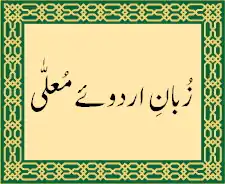

The Urdu alphabet is a right-to-left alphabet. It is a modification of the Persian alphabet, which is itself a derivative of the Arabic alphabet. With 38 letters, the Urdu alphabet is typically written in the calligraphic Nasta'liq script.
Sindhi adopted a variant of the Persian alphabet as well, in the 19th century. The script is used in Pakistan today, albeit unlike most other native languages of Pakistan, the Naskh style is more common for Sindhi writing than the Nasta'liq style. It has a total of 52 letters, augmenting the Urdu with digraphs and eighteen new letters (ڄ ٺ ٽ ٿ ڀ ٻ ڙ ڍ ڊ ڏ ڌ ڇ ڃ ڦ ڻ ڱ ڳ ڪ) for sounds particular to Sindhi and other Indo-Aryan languages. Some letters that are distinguished in Arabic or Persian are homophones in Sindhi.
Balochi and Pashto are written in Perso-Arabic script. The Shahmukhī script, a variant of the Urdu alphabet, is used to write the Punjabi language in Pakistan.
Usually, bare transliterations of Urdu into Roman letters, Roman Urdu, omit many phonemic elements that have no equivalent in English or other languages commonly written in the Latin script. The National Language Authority of Pakistan has developed a number of systems with specific notations to signify non-English sounds, but these can only be properly read by someone already familiar with Urdu.
Maps
This is a series of maps which shows the distribution of different languages in Pakistan as of the 2017 Pakistan Census. These all refer to the mother tongues of individuals only.
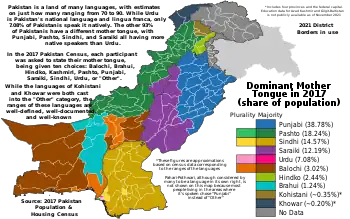
 Percent speaking Punjabi natively
Percent speaking Punjabi natively Percent speaking Pashto natively
Percent speaking Pashto natively Percent speaking Sindhi natively
Percent speaking Sindhi natively Percent speaking Saraiki natively
Percent speaking Saraiki natively Percent speaking Urdu natively
Percent speaking Urdu natively Percent speaking Balochi natively
Percent speaking Balochi natively Percent speaking Hindko natively
Percent speaking Hindko natively Percent speaking Brahui natively
Percent speaking Brahui natively Percent speaking a minor language (not collected on the census) natively in 1998.
Percent speaking a minor language (not collected on the census) natively in 1998.
See also
Notes
- ↑ Also known as Lashkari (لشکری)[2]
- ↑ Lack of exact numbers of speakers of the language due to not being represented in the previous censuses. Upcoming 2022 Census of Pakistan will include Pahari-Pothwari as an option. Baart (2003, p. 10) provides an estimate of 3.8 million, presumably for the population in Pakistan alone. Lothers & Lothers (2010, p. 9) estimate the Pakistani population at well over 2.5 million and the UK diaspora at over 0.5 million. The population in India is reported in Ethnologue (2017) to be about 1 million as of 2000.
- ↑ Excluding large urban centres
- ↑ The term Hindki normally refers to a Hindko speaker and Shackle (1980, p. 482) reports that in Pashto the term has slightly pejorative connotations, which are avoided with the recently introduced term Hindkūn.
References
- ↑ "Article: 251 National language". Retrieved 23 July 2018.
- ↑ Singh, Shashank, and Shailendra Singh. "Systematic review of spell-checkers for highly inflectional languages." Artificial Intelligence Review 53.6 (2020): 4051-4092.
- 1 2 Ashraf, Hina (22 March 2022). "The ambivalent role of Urdu and English in multilingual Pakistan: a Bourdieusian study". Language Policy. 22 (1): 25–48. doi:10.1007/s10993-022-09623-6. ISSN 1573-1863. PMC 8939399. PMID 35340722.
- 1 2 Ashraf, Muhammad Azeem; Turner, David A.; Laar, Rizwan Ahmed (January 2021). "Multilingual Language Practices in Education in Pakistan: The Conflict Between Policy and Practice". SAGE Open. 11 (1): 215824402110041. doi:10.1177/21582440211004140. ISSN 2158-2440. S2CID 232484396.
- ↑ Rengel, Marian (15 December 2003). Pakistan: A Primary Source Cultural Guide. The Rosen Publishing Group, Inc. p. 38. ISBN 978-0-8239-4001-1.
- ↑ Kachru, Braj B.; Kachru, Yamuna; Sridhar, S. N. (27 March 2008). Language in South Asia. Cambridge University Press. p. 34. ISBN 978-1-139-46550-2.
- ↑ "POPULATION BY MOTHER TONGUE, SEX AND RURAL/ URBAN" (PDF). www.pbs.gov.pk. Pakistan Bureau of Statistics.
- 1 2 3 4 Eberhard, Simons & Fennig 2022.
- ↑ "Endangered Languages Project - Torwali - Challenges to the linguistic diversity of North Pakistan". www.endangeredlanguages.com. Retrieved 11 June 2023.
- ↑ "Final Results of Census-2017". Retrieved 7 August 2021.
- ↑ "Final Results of Census-2017". Retrieved 7 August 2021.
- ↑ Muzaffar, Sharmin; Behera, Pitambar (2014). "Error analysis of the Urdu verb markers: a comparative study on Google and Bing machine translation platforms". Aligarh Journal of Linguistics. 4 (1–2): 1.
Modern Standard Urdu, a register of the Hindustani language, is the national language, lingua-franca and is one of the two official languages along with English in Pakistan and is spoken in all over the world. It is also one of the 22 scheduled languages and officially recognized languages in the Constitution of India and has been conferred the status of the official language in many Indian states of Bihar, Telangana, Jammu, and Kashmir, Uttar Pradesh, West Bengal, and New Delhi. Urdu is one of the members of the new or modern Indo-Aryan language group within the Indo-European family of languages.
- ↑ "PAKISTAN". Official U.S. Marine Corps.
- ↑ The World Factbook. Central Intelligence Agency. 1992. p. 264.
- ↑ "Dec 25, 2017 | Why did the Quaid make Urdu Pakistan's state language?". Dawn Epaper. 25 December 2017.
- ↑ "EDUCATION SYSTEM PROFILES Education in Pakistan". World Education Services. 25 February 2020.
English has been the main language of instruction at the elementary and secondary levels since colonial times. It remains the predominant language of instruction in private schools but has been increasingly replaced with Urdu in public schools. Punjab province, for example, recently announced that it will begin to use Urdu as the exclusive medium of instruction in schools beginning in 2020. Depending on the location and predominantly in rural areas, regional languages are used as well, particularly in elementary education. The language of instruction in higher education is mostly English, but some programs and institutions teach in Urdu.
- ↑ Robina Kausar; Muhammad Sarwar; Muhammad Shabbir (eds.). "The History of the Urdu Language Together with Its Origin and Geographic Distribution" (PDF). International Journal of Innovation and Research in Educational Sciences. 2 (1).
- ↑ Ahmad, Aijazuddin (2009). Geography of the South Asian Subcontinent: A Critical Approach. Concept Publishing Company. ISBN 978-81-8069-568-1.
- ↑ Hock, Hans Henrich; Bashir, Elena (24 May 2016). The Languages and Linguistics of South Asia: A Comprehensive Guide. Walter de Gruyter GmbH & Co KG. ISBN 978-3-11-042330-3.
- ↑ Raj, Ali (30 April 2017). "The case for Urdu as Pakistan's official language". Herald Magazine. Archived from the original on 28 October 2019. Retrieved 28 October 2019.
- ↑ "Pakistan to replace English with Urdu as official language – The Express Tribune". The Express Tribune. 29 July 2015. Retrieved 5 January 2016.
- ↑ "CCI defers approval of census results until elections". Dawn. 21 March 2021. Retrieved 10 March 2021. The figure of 80.54 million is calculated from the reported 38.78% for the speakers of Punjabi and the 207.685 million total population of Pakistan.
- ↑ Bhatia, Tej (1999). "Lexican Anaphors and Pronouns in Punjabi". In Lust, Barbara; Gair, James (eds.). Lexical Anaphors and Pronouns in Selected South Asian Languages. Walter de Gruyter. p. 637. ISBN 978-3-11-014388-1. Other tonal Indo-Aryan languages include Hindko, Dogri, Western Pahari, Sylheti and some Dardic languages.
- ↑ Sharmeen Obaid-Chinoy (17 July 2009). "Karachi's Invisible Enemy". PBS. Retrieved 24 August 2010.
- ↑ "In a city of ethnic friction, more tinder". The National. 24 August 2009. Archived from the original on 16 January 2010. Retrieved 24 August 2010.
- ↑ "Columnists | The Pakhtun in Karachi". Time. 28 August 2010. Retrieved 8 September 2011.
- ↑ Archived 9 December 2012 at archive.today, thefridaytimes
- ↑ Lieven, Anatol (4 May 2021). "An Afghan Tragedy: The Pashtuns, the Taliban and the State". Survival. 63 (3): 7–36. doi:10.1080/00396338.2021.1930403. ISSN 0039-6338. S2CID 235219004.
- ↑ "Sindhi". The Languages Gulper. Retrieved 29 January 2013.
- ↑ Wadhwani, Y. K. (1981). "The Origin of the Sindhi Language" (PDF). Bulletin of the Deccan College Post-Graduate and Research Institute. 40: 192–201. JSTOR 42931119. Retrieved 9 April 2021.
- ↑ "Encyclopædia Britannica". Britannica.com. Retrieved 11 May 2013.
- ↑ "Sindhi Language – Structure, Writing & Alphabet". Mustgo.com. Retrieved 1 March 2022.
- ↑ Parekh, Rauf (30 September 2008). "The Sindhi language and its variations". DAWN.COM. Retrieved 26 May 2023.
- ↑ Rahman 1995, p. 16; Shackle 2014b
- ↑ Shackle 1977, p. 389.
- ↑ Shackle 2014b.
- ↑ "Saraiki". Ethnologue.
- ↑ Rahman 1996, p. 211.
- ↑ Shackle 1979, pp. 200–1.
- ↑ Shackle 1980, p. 486.
- ↑ Shackle 1980, p. 482; Rensch 1992, pp. 3–4. See there for alternative etymologies.
- ↑ Rensch 1992, p. 4.
- ↑ Parkin 1989, p. 37.
- ↑ Gordon, Raymond G., Jr. (2005). Languages of Pakistan. In Ethnologue Languages of the World (15th ed.). Dallas, TX: SIL International.
- 1 2 3 4 5 6 7 8 9 10 11 12 13 14 15 16 17 18 19 20 21 22 23 24 25 26 27 28 29 Moseley, Christopher, ed. (2010). Atlas of the World' s Languages in Danger. Memory of Peoples (3rd ed.). Paris: UNESCO Publishing. ISBN 978-92-3-104096-2. Retrieved 11 April 2015.
- ↑ "UNESCO Atlas of the World's Languages in danger". www.unesco.org.
- ↑ Constitution of Pakistan: Constitution of Pakistan, 1973 - Article: 31 Islamic way of life Archived 26 August 2018 at the Wayback Machine, 1973, retrieved 28 July 2018
- ↑ Ministry of Federal Education and Professional Training: National Education Policy 2017, p. 25, retrieved 28 July 2018
- ↑ Clinton Bennett; Charles M. Ramsey (1 March 2012). South Asian Sufis: Devotion, Deviation, and Destiny. A&C Black. p. 18. ISBN 978-1-4411-5127-8.
- ↑ "Hazaragi (آزرگی)". omniglot.com.
- ↑ "UF elections victory". Chronicles of Pakistan. Archived from the original on 18 January 2012. Retrieved 11 December 2011.
- ↑ Shah Meer Baloch (21 November 2017). "Asia Why are Pakistanis keen to learn Chinese language?". Deutsche Welle.
- ↑ Marian Rengel Pakistan: A Primary Source Cultural Guide page 38 ISBN 0823940012, 9780823940011
- ↑ Mukhtar Ahmed Ancient Pakistan - an Archaeological History pages 6-7 ISBN 1495966437, 9781495966439
- ↑ Concise Encyclopedia of Languages of the World (page 283)
- ↑ Burde, Jayant (2004). Rituals, Mantras, and Science: An Integral Perspective. Motilal Banarsidass Publishers. p. 3. ISBN 978-81-208-2053-1.
The Aryans spoke an Indo-European language sometimes called the Vedic language from which have descended Sanskrit and other Indic languages ... Prakrit was a group of variants which developed alongside Sanskrit.
- ↑ Jain, Danesh; Cardona, George (26 July 2007). The Indo-Aryan Languages. Routledge. p. 163. ISBN 978-1-135-79711-9.
... a number of their morphophonological and lexical features betray the fact that they are not direct continuations of R̥gvedic Sanskrit, the main base of 'Classical' Sanskrit; rather they descend from dialects which, despite many similarities, were different from R̥gvedic and in some regards even more archaic.
- ↑ Chamber's Encyclopaedia, Volume 7. International Learnings Systems. 1968.
Most Aryan languages of India and Pakistan belong to the Indo-Aryan family, and are descended from Sanskrit through the intermediate stage of Prakrit. The Indo-Aryan languages are by far the most important numerically and the territory occupied by them extends over the whole of northern and central India and reaches as far south as Goa.
- ↑ Donkin, R. A. (2003). Between East and West: The Moluccas and the Traffic in Spices Up to the Arrival of Europeans. American Philosophical Society. p. 60. ISBN 9780871692481.
The modern, regional Indo-Aryan languages developed from Prakrt, an early 'unrefined' (prakrta) form of Sanskrit, around the close of the first millennium A.D.
- ↑ ISO 639 code sets. Sil.org. Retrieved on 2011-01-14.
- ↑ Shackle 1979, p. 198.
- ↑ Languages of Pakistan at Ethnologue (18th ed., 2015) (subscription required)
- ↑ ISO 639 code sets. Sil.org. Retrieved on 2011-01-14.
- ↑ ISO 639 code sets. Sil.org. Retrieved on 2011-01-14.
- ↑ WALS – Sino-Tibetan. Wals.info. Retrieved on 2011-01-14
- ↑ Naim, C. M. (1999), Ambiguities of Heritage: Fictions and Polemics, City Press, p. 87, ISBN 978-969-8380-19-9
Bibliography
- Baart, Joan L. G. (2003). Sustainable Development and the Maintenance of Pakistan's Indigenous Languages. Islamabad.
- Eberhard, David M; Simons, Gary F.; Fennig, Charles D., eds. (2022). "Pakistan". Ethnologue: Languages of the World (25 ed.). Dallas, Texas: SIL International.
- Lothers, Michael; Lothers, Laura (2010). Pahari and Pothwari: A Sociolinguistic Survey (Report). SIL Electronic Survey Reports. Vol. 2010–012.
- Rahman, Tariq (1996) Language and Politics of Pakistan Karachi: Oxford University Press. New Delhi: Orient Blackswan, 2007.
- Rahman, Tariq (2002) Language, Ideology and Power: Language-learning among the Muslims of Pakistan and North India Karachi: Oxford University Press. Rev.ed. New Delhi: Orient Blackswan, 2008.
- Rahman, Tariq (2011) From Hindi to Urdu: A Social and Political History Karachi: Oxford University Press.
- Simons, Gary F.; Fennig, Charles D., eds. (2017). "Pahari-Potwari". Ethnologue (20 ed.). (access limited).
- Rahman, Tariq (1995). "The Siraiki Movement in Pakistan". Language Problems & Language Planning. 19 (1): 1–25. doi:10.1075/lplp.19.1.01rah.
- —— (2014b). "Siraiki language". Encyclopædia Britannica. Retrieved 18 October 2016.
- —— (1977). "Siraiki: A Language Movement in Pakistan". Modern Asian Studies. 11 (3): 379–403. doi:10.1017/s0026749x00014190. ISSN 0026-749X. JSTOR 311504. S2CID 144829301.
- Rahman, Tariq (1996). Language and politics in Pakistan. Oxford University Press. ISBN 978-0-19-577692-8.
- Shackle, Christopher (1979). "Problems of classification in Pakistan Panjab". Transactions of the Philological Society. 77 (1): 191–210. doi:10.1111/j.1467-968X.1979.tb00857.x. ISSN 0079-1636.
- Shackle, Christopher (1980). "Hindko in Kohat and Peshawar". Bulletin of the School of Oriental and African Studies. 43 (3): 482–510. doi:10.1017/S0041977X00137401. ISSN 0041-977X. S2CID 129436200.
- Rensch, Calvin R. (1992). "The Language Environment of Hindko-Speaking People". In O'Leary, Clare F.; Rensch, Calvin R.; Hallberg, Calinda E. (eds.). Hindko and Gujari. Sociolinguistic Survey of Northern Pakistan. Islamabad: National Institute of Pakistan Studies, Quaid-i-Azam University and Summer Institute of Linguistics. ISBN 969-8023-13-5.
- Parkin, Robert (1989). "Some comments on Brahui kinship terminology". Indo-Iranian Journal. 32 (1): 37–43. doi:10.1163/000000089790082944. JSTOR 24654607. S2CID 161638780.
External links
- Linguistic map of Pakistan at Muturzikin.com
- Pakistan census statistics by population
- List of Pakistani Languages at Ethnologue


